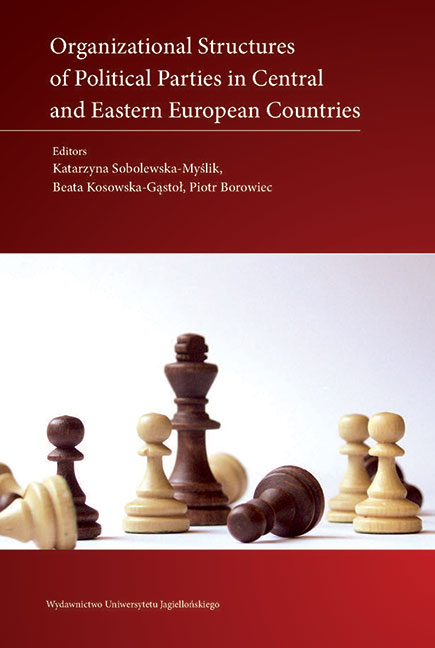Book contents
- Frontmatter
- Contents
- Preface
- Developing Party Structures in Central and Eastern Europe
- Albania: Organizations of Political Parties in Albania
- Belarus: Belarusian Political Parties: Organizational Structures and Practices
- Bosnia and Herzegovina: Organizational Structures of Political Parties in CEE Countries: A Case Study on Bosnia and Herzegovina
- Bulgaria: Organizational Structure and Trends in Bulgarian Party Politics
- Croatia: Organizational Structures of Political Parties in Croatia
- Czech Republic: Between Organizational Extremes: Czech Parties after a Political Earthquake
- Estonia: Organizational Structures of Political Parties in Estonia
- Hungary: Cut from the Same Cloth? A Comparative Analysis of Party Organizations in Hungary
- Kosovo: Structure of the Main Political Parties in Kosovo
- Latvia: Leader-Centered and Power-Hungry: Party Organizations in Latvia
- Lithuania: Organization of Political Parties: The Case of Lithuania
- Moldova: Organizational Structures of Political Parties in The Republic of Moldova
- Montenegro: Party Organization in Montenegro: Structural Resemblance Behind Political Divergence
- Poland: Structures of Polish Political Parties in the Second Decade of the 21st Century
- Romania: The Internal Organization of Romanian Political Parties
- Russia: Parties with Roots Growing Upwards: Organizational Features of Russian Political Parties
- Serbia: Organizational Structures of Political Parties in Serbia
- Slovakia: Organizational Structures of Political Parties in Slovakia: Parties not for Members
- Slovenia: Almost without Any Innovations: Organizational Structures in Slovenian Parties
- Ukraine: Shallow Party Structures in a Volatile Party System
- Comparing Organizational Structures of Political Parties in Central and Eastern European Countries
- Biographical notes about the authors
Slovakia: Organizational Structures of Political Parties in Slovakia: Parties not for Members
- Frontmatter
- Contents
- Preface
- Developing Party Structures in Central and Eastern Europe
- Albania: Organizations of Political Parties in Albania
- Belarus: Belarusian Political Parties: Organizational Structures and Practices
- Bosnia and Herzegovina: Organizational Structures of Political Parties in CEE Countries: A Case Study on Bosnia and Herzegovina
- Bulgaria: Organizational Structure and Trends in Bulgarian Party Politics
- Croatia: Organizational Structures of Political Parties in Croatia
- Czech Republic: Between Organizational Extremes: Czech Parties after a Political Earthquake
- Estonia: Organizational Structures of Political Parties in Estonia
- Hungary: Cut from the Same Cloth? A Comparative Analysis of Party Organizations in Hungary
- Kosovo: Structure of the Main Political Parties in Kosovo
- Latvia: Leader-Centered and Power-Hungry: Party Organizations in Latvia
- Lithuania: Organization of Political Parties: The Case of Lithuania
- Moldova: Organizational Structures of Political Parties in The Republic of Moldova
- Montenegro: Party Organization in Montenegro: Structural Resemblance Behind Political Divergence
- Poland: Structures of Polish Political Parties in the Second Decade of the 21st Century
- Romania: The Internal Organization of Romanian Political Parties
- Russia: Parties with Roots Growing Upwards: Organizational Features of Russian Political Parties
- Serbia: Organizational Structures of Political Parties in Serbia
- Slovakia: Organizational Structures of Political Parties in Slovakia: Parties not for Members
- Slovenia: Almost without Any Innovations: Organizational Structures in Slovenian Parties
- Ukraine: Shallow Party Structures in a Volatile Party System
- Comparing Organizational Structures of Political Parties in Central and Eastern European Countries
- Biographical notes about the authors
Summary
Introduction
Competitive political parties have been one of a key determinant of political change and in the institutionalization of democracy in post-communist Central and Eastern Europe (Lewis 2000). An understanding of this process requires analysis of the party systems as well as individual political parties, including their organization (Kopecký 2006; Rybář 2006), stability (Haughton 2014a; Bakke and Sitter 2013), causes of emergence and dissolution (Haughton and Deegan-Krause 2015), relationships with the state (Haughton 2008), and how they have been impacted by EU accession (Vachudova 2008; Henderson 2009; Haughton 2014b).
In the case of post-communist democracies, many political leaders usually do not consider party organization as important pre-condition for the success of parties in elections. For party competition and success in elections media campaigns, strong and visible leaders, and patronage are more relevant. However, party organization appears to be important to the successful establishment and long-term survival of parties (Tavits 2013; Haughton and Deegan-Krause 2015). Previous studies examining the organization of political parties in Slovakia (Rybář 2004, 2006, 2011a; Lášticová and Malová 2013) reveal their elite-created and centralized organizations. This scholarship as well emphasizes parties’ financial dependency on the state, minimal number of members, weak linkages with society and organized interests, including underdeveloped territorial organizations. New trends in development of parties, in particular the emergence of anti-establishment protest parties (Hanley and Sikk 2016; Haughton and Deegan-Krause 2015) have just confirmed these tendencies. Thus political parties in Slovakia are organizationally much weaker than their western counterparts.
This chapter aims to characterize the state of party organization in Slovakia by providing a more detailed description of the structure and functioning of parties represented in the national Parliament during the 2010–2016 legislative term.
Political Position, Legal Framework, and Basic Features of Political Parties in Slovakia
Given the PR electoral system with a closed party list, political parties are the dominant political actors in Slovakia. Slovakia has applied proportional representation since the first parliamentary elections after the fall of the communist regime. Key parameters of the electoral system were stabilized in the 1990s. There have since been few – but important – changes.
- Type
- Chapter
- Information
- Organizational Structures of Political Parties in Central and Eastern European Countries , pp. 391 - 418Publisher: Jagiellonian University PressPrint publication year: 2017



